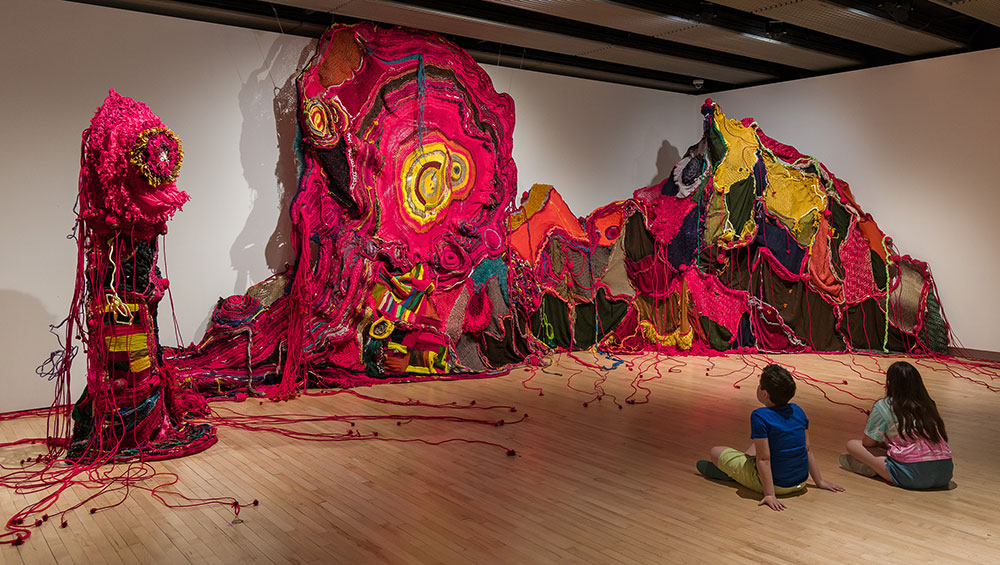
Installation view of Aluaiy Kaumakan, Dear Earth: Art and Hope in a Time of Crisis (21 Jun – 3 Sep 2023). Photo: Mark Blower. Courtesy the Hayward Gallery.
Hayward Gallery, London
21 June – 3 September 2023
by VERONICA SIMPSON
It is hard not to approach exhibitions of environmental art with a certain amount of doom and gloom. After all, our planet is not in great shape, and our governments and prevailing consumer habits are doing little to change that. But I had been lured to the Hayward’s Dear Earth show by its upbeat subtitle: Art and Hope in a Time of Crisis. The wall caption went further: the 15 “pioneering artists” selected for the show, we are told, have made work that “invites us to imaginatively rethink our responses to many of today’s major environmental issues”. It cites the assertion of one of these artists, Otobong Nkanga, that “care is a form of resistance”, and suggests that the assembled artists’ imagined “ecology of hope and spiritual connection” will deepen our engagement with the subject, and possibly even change our responses. The latter strikes me as a rather troubling kind of magical thinking. Can an art exhibition really do all that?
.jpg)
Installation view of Otobong Nkanga, Dear Earth: Art and Hope in a Time of Crisis (21 Jun – 3 Sep 2023). Photo: Mark Blower. Courtesy the Hayward Gallery.
The Nigerian-born, Belgium-based Nkanga has long been imagining and visualising the connections between ancient, extractive and colonial practices and our current reality. I interviewed her for Studio International in 2018 when Double Plot (2018), which is also the main work in her Hayward installation, was part of her Artes Mundi shortlist show in Cardiff. At the time, I was struck by the subtlety of her presentation, the rich threads she drew (literally and figuratively) with that tapestry and its accompanying sculpture in the imaginative realm of how people, plants and planets are connected. Today, there is nothing subtle about the dead tree she has placed in the centre of the gallery, leaning away from us and towards the “living” tree in Double Plot. But there is subtlety and artistry aplenty in the works around it, and especially in In Pursuit of Bling (2014), the video work in the adjacent darkened room. Here, Nkanga introduces a pile of stones that represent the minerals typically extracted from her Nigerian homeland by its colonial oppressors. Shining in the otherwise dark, cave-like setting, they become a kind of bed for her “Earth Mother” meditating figure, before transforming into a handful of sequins that she casts into the air, turning them into a galaxy of stars that land across her face, lips and cheeks. We are all stardust, the work reminds us, linking the interplanetary and the cosmic with the visceral and the here and now. As she told me in 2018: “When we look at the stars, we see something manifesting now but … it happened light years before, and so what appears is what we see, but it’s taken time to reach our eyes. This is all part of (my) thinking about the lines and the borders in the work - lines that are demarcating land, the veins that go through the body. How do those lines affect the people living within those landscapes? What we get to see over time is more or less the latent effects of dividing groups of people, dividing borders.”
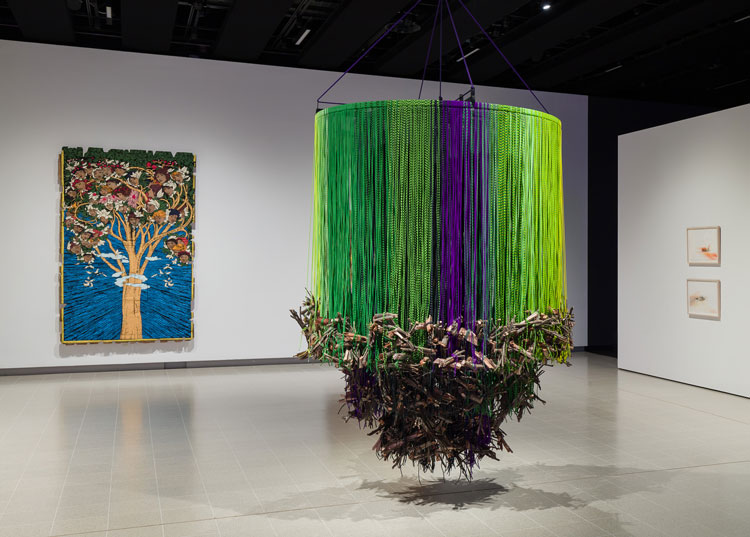
Installation view of Andrea Bowers, Dear Earth: Art and Hope in a Time of Crisis (21 Jun – 3 Sep 2023). Photo: Mark Blower. Courtesy the Hayward Gallery.
Those same issues dominate the second gallery, which hosts Andrea Bowers’ work, introduced by the neon piece Climate Change is Real (2017) at the top of the access ramp, the word “real” winking on and off as if to acknowledge the fake news propaganda that would deny the reality. The centrepiece is a circular hanging of colourful climbing ropes and tree scraps. Memorial to Arcadia Woodlands Clear-Cut (Green, Violet and Brown) is a commemorative artwork inspired by the time she spent protesting against the proposed destruction of a forest in California. She and other activists tied themselves to the trees, but in vain: they were arrested and the forest was cut down. Bowers returned to gather the remaining ropes, pieces of bark, woodchips and twigs that comprise this piece.
Around the walls are other works from her Eco Grief Extinction series, lamenting the loss of Hawaiian flora and fauna. These feature quotes from Deena Metzger, a healer and poet, as does Now That We Know (2021), which Bowers made during the darkest days of the Coronavirus pandemic, responding to a poem simultaneously written by Metzger, which opens: “Now that we are sequestered, an entire globe aware that we are sharing a common fate, which has always been the case.” It weaves its handwritten way around the edges of the frame, and ends with: “Now that we know we are mortal might we, for this just moment, hold a broken prayer that our hearts open wide and with such wisdom that life will pity us, will restore the thousand beings, and give us another humbler round.” Unfortunately, the power of Metzger’s words is diminished by how tiny they are and the fact that they weave around the work at a height that makes reading them almost impossible (unless you photograph the work and unpick it later, in your own time, which I did). But the works I find most immediately affecting here are also quieter and smaller in scale (albeit larger than Metzger’s poem): a tightly cropped photograph of underwater activists with a placard reading “It’s Getting Hot Down Here”, presented in an enormous frame (Step It Up Activist, Sand Key Reef, Key West, Florida, Part of North America’s Only Remaining Coral Barrier Reef, 2009) and two beautiful pencil and pastel drawings of dead birds from her 2023 series The Dead Silence of Extinction. I felt a lump rise in my throat as I contemplated their soft, still, extinct forms.
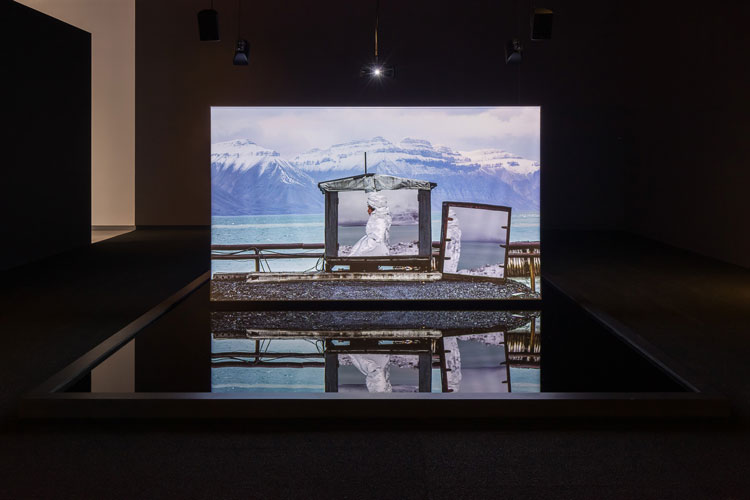
Installation view of Himali Singh Soin, Dear Earth: Art and Hope in a Time of Crisis (21 Jun – 3 Sep 2023). Photo: Mark Blower. Courtesy the Hayward Gallery.
All three of the early galleries are infused with the plangent sound of a string quartet, a bespoke composition conjured by Himali Singh Soin for the two videos she is showing in the third space. That soundtrack further dampens any residue of hope or optimism I might feel, and her installation does likewise. But it is certainly beautiful: two screens are set back to back within an oblong pool of water that reflects the near-monochrome imagery of rusting metal yards, documentary footage of melting icecaps at the Arctic and Antarctic, vintage botanical drawings, Victorian cartoons depicting the end of the world (which they thought would be due to a new ice age rather than global warming), and the imaginary, alien figure she is playing throughout, called Ice. We Are Opposite Like That is an ongoing series of video, performance, poetry and textiles.
I am, however, cheered by words on the wall as I move through the stairs and corridor into the rear galleries. They come from the botanist and eco activist Robin Wall Kimmerer, whose books Braiding Sweetgrass and Gathering Moss helped keep me sane during the pandemic years. “Even a wounded world is feeding us. Even a wounded world holds us, giving us moments of wonder and joy. I choose joy over despair. Not because I have my head in the sand, but because joy is what the Earth gives me daily and I must return the gift.”
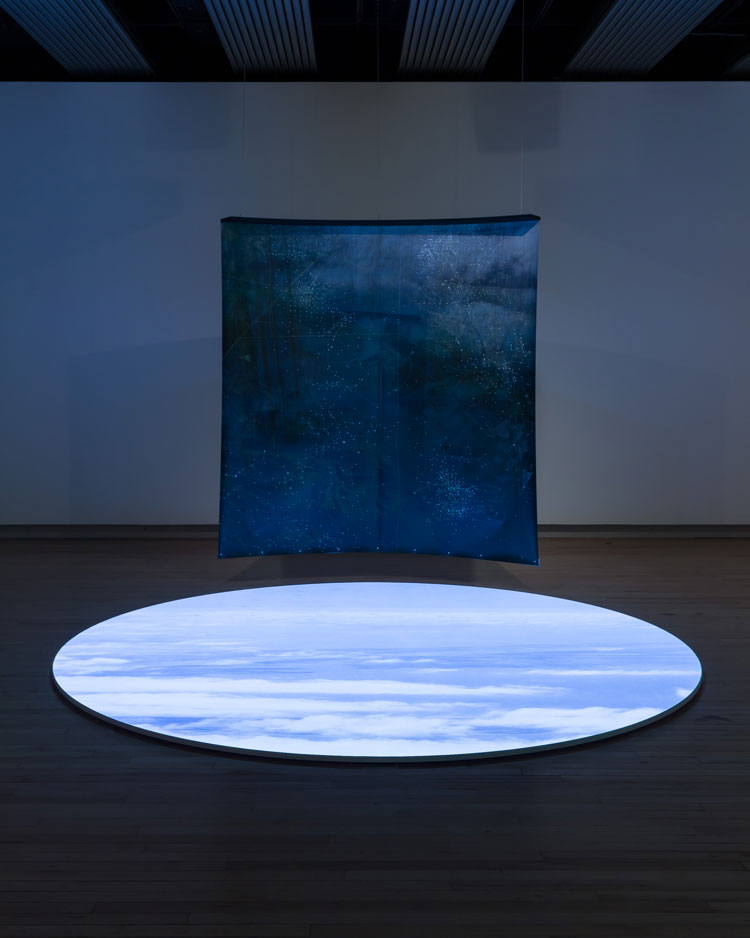
Installation view of Imani Jacqueline Brown, Dear Earth: Art and Hope in a Time of Crisis (21 Jun – 3 Sep 2023). Photo: Mark Blower. Courtesy the Hayward Gallery.
There is little to comfort us, however, in the art that follows. Imani Jacqueline Brown’s work here is focused on the 300-year history of oil extraction in Louisiana, which has polluted huge tracts of land, poisoning the ground, people and culture. Her installation, What Remains at the Ends of the Earth?, comprises documentary film, archival maps and satellite images, revealing a toxic web of oil wells crisscrossing burial grounds for enslaved people.
A lightening of mood, or at least materials, is palpable in the following ground floor galleries. Aluaiy Kaumakan’s textile sculptures evoke the topography and traditions of her Taiwanese community. They share space with several huge portraits of London-based eco activists, by Ackroyd & Harvey. Made with blades of grass grown from seed embedded in the frames, the portraits transform uncannily from a grey monochrome blur to bright-green images when viewed through a digital camera/phone screen, in what the artists call “photographic photosynthesis”. The colour we see is activated by light from the projector. As they explain in the caption: “Where the light falls, the grass blades produce chlorophyll, the green pigment. Where there’s less light, they produce less green. Where there’s no light, they grow, but are yellow. Plants convert the carbon dioxide in the atmosphere and give the planet oxygen. Photosynthesis is critical for the existence of most life on Earth.”
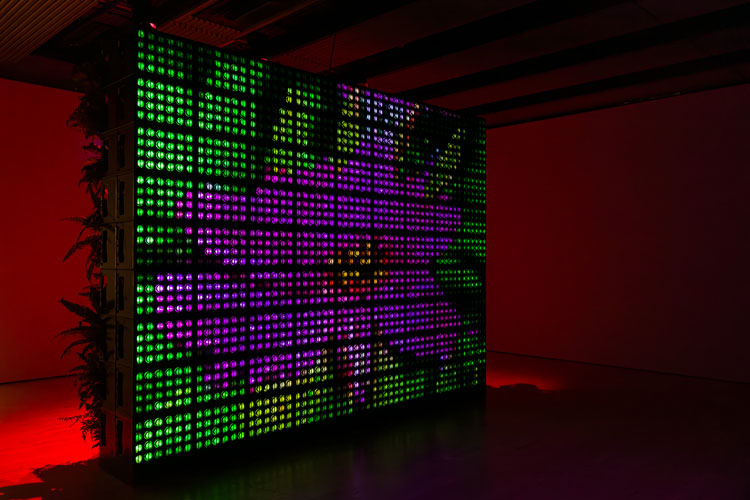
Installation view of Hito Steyerl, Dear Earth: Art and Hope in a Time of Crisis (21 Jun – 3 Sep 2023). Photo: Mark Blower. Courtesy the Hayward Gallery.
In the next room, pulsating bursts of colour and energy emerge from Hito Steyerl’s Green Screen installation. On the reverse of an LED screen constructed largely from empty bottles is a wall of live plants. Bioelectric signals from the plants are translated into colours, sound and shapes that appear on the screen, with each bottle acting as a single pixel. In its bright colouring and simplicity, it is incredibly appealing, as is Cornelia Parker’s two-screen work in the subsequent room, The Future (Sixes and Sevens) (2023), in which six- and seven-year-olds are asked about their hopes for the future.
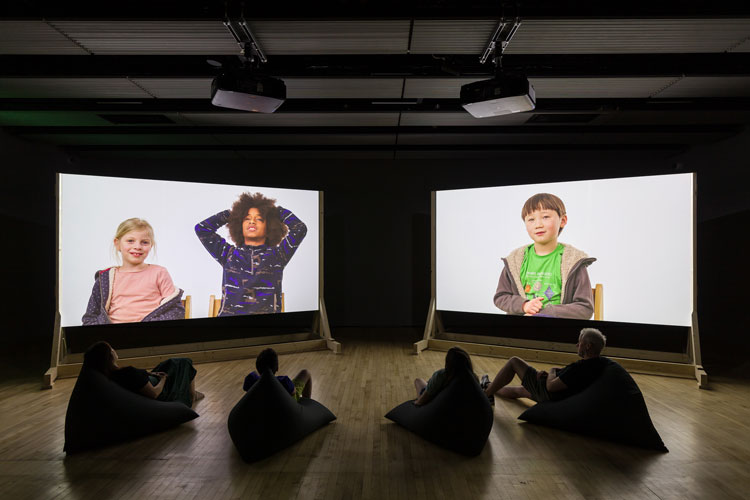
Installation view of Cornelia Parker, Dear Earth: Art and Hope in a Time of Crisis (21 Jun – 3 Sep 2023). Photo: Mark Blower. Courtesy the Hayward Gallery.
Touching only very occasionally on the climate crisis, Parker hopes it will make us wake up to the fact that we are the only ones who can act to ensure that these children have a future that even vaguely resembles their dreams.
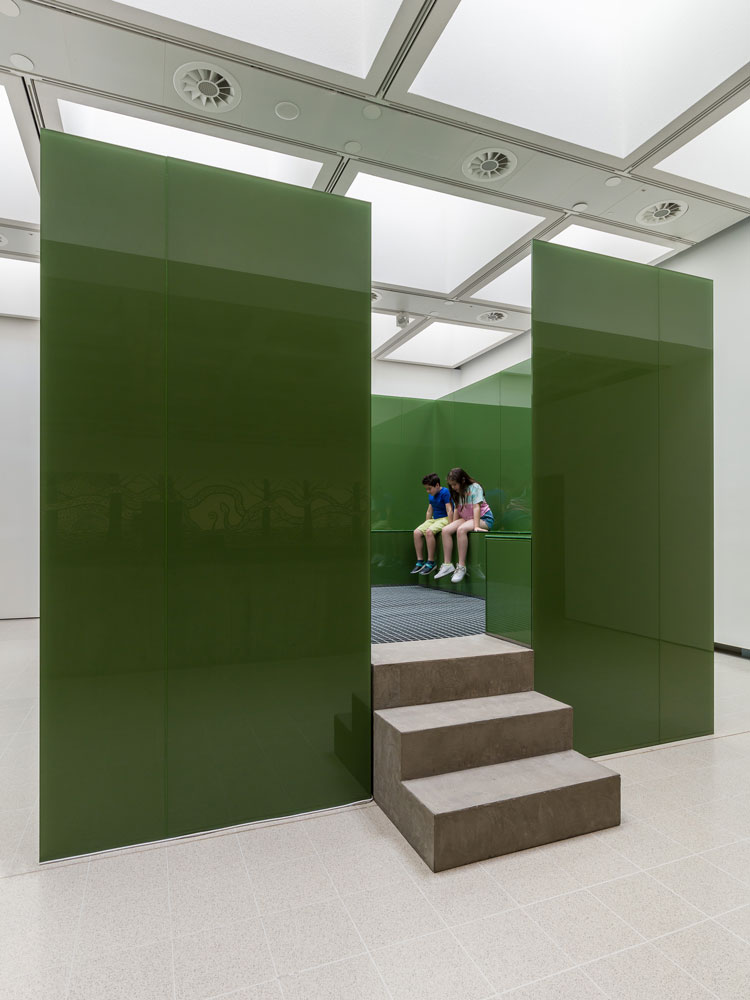
Installation view of Cristina Iglesias, Dear Earth: Art and Hope in a Time of Crisis (21 Jun – 3 Sep 2023). Photo: Mark Blower. Courtesy the Hayward Gallery.
After ascending the Hayward’s concrete staircase to the top floor, we are greeted with a green glass cube structure housing Cristina Iglesias’ latest fountain, Pabellón de Cristal 1. Stepping up into the cube, we find we are standing on a metal grid. Below it water gurgles and swishes into one of her customary geologically inspired formations. This segues nicely into Daiara Tukano’s wall drawing Ohpëko Pati – World of the Sacred Waters of the Grand Mother of the Universe (2023) and then some exquisite Agnes Denes ink and silkscreen works, followed by a room filled, floor to ceiling, with one of her Living Pyramid structures.
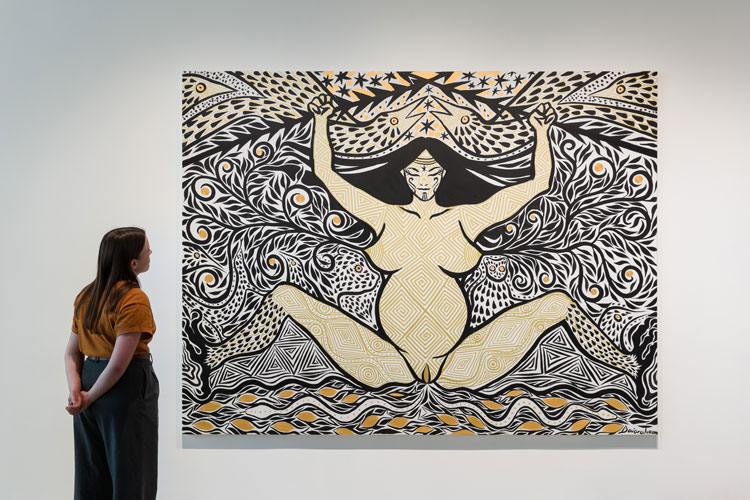
Installation view of Daiara Tukano, Dear Earth: Art and Hope in a Time of Crisis (21 Jun – 3 Sep 2023). Photo: Mark Blower. Courtesy the Hayward Gallery.
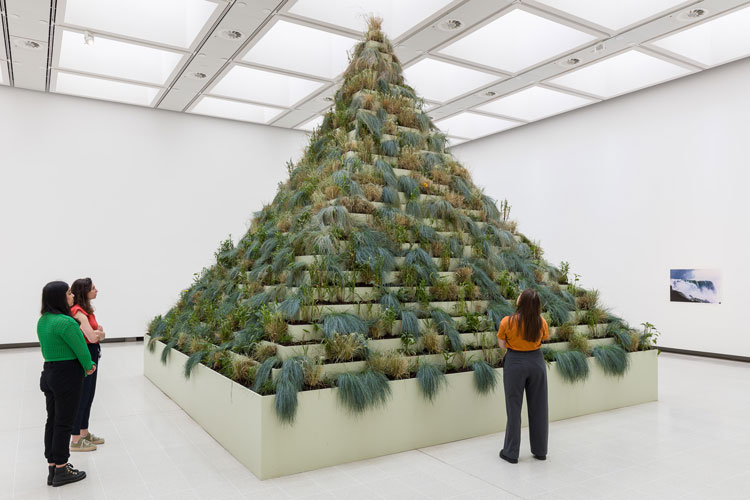
Installation view of Agnes Denes, Dear Earth: Art and Hope in a Time of Crisis (21 Jun – 3 Sep 2023). Photo: Mark Blower. Courtesy the Hayward Gallery.
Though the plants were a little young at the start of the show, this work will clearly evolve over the summer. There are also large photographic stills from the documentaries of her remarkable live action projects Tree Mountain (1992-96) and her radical Wheatfield project, which entailed planting and harvesting a huge field of golden wheat on an empty construction site in Manhattan in 1982.
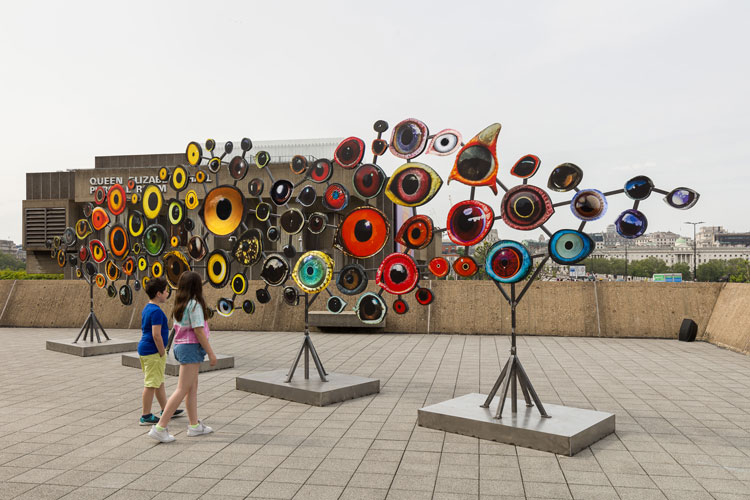
Installation view of Jenny Kendler, Dear Earth: Art and Hope in a Time of Crisis (21 Jun – 3 Sep 2023). Photo: Mark Blower. Courtesy the Hayward Gallery.
Outside - appropriate for its lofty, roof terrace location – is Jenny Kendler’s Birds Watching III, which features a sculptural installation of the enlarged eyes of 100 bird species staring back at us. There is also a sound installation, Tell It to the Birds, where you can whisper a secret into a microphone in a charming moss and steel enclosure and have it translated into birdsong.
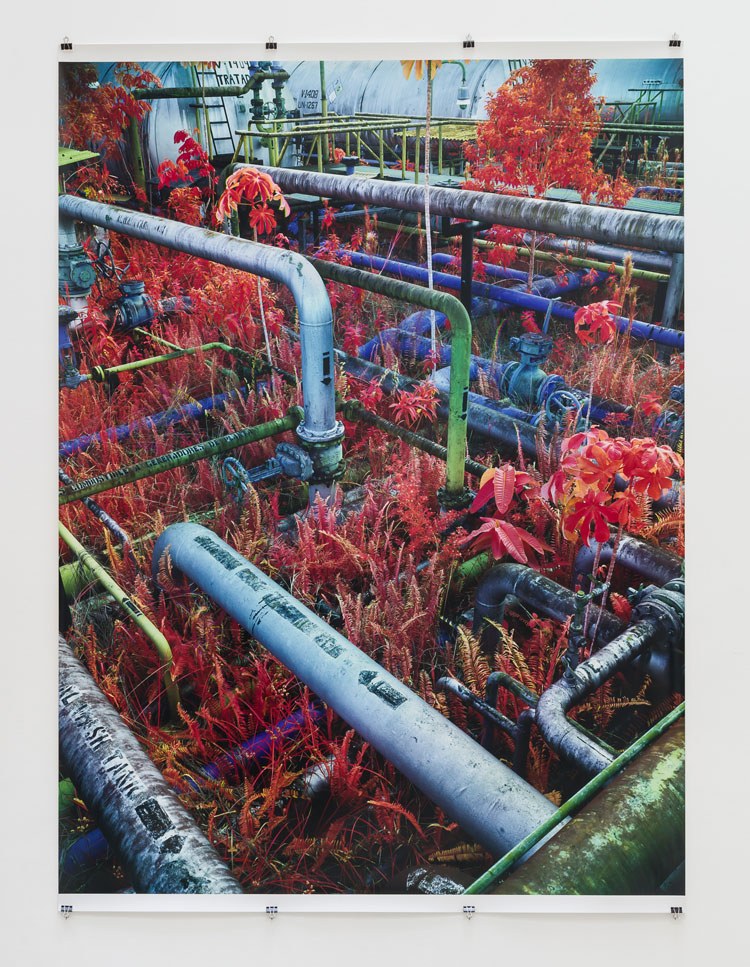
Installation view of Richard Mosse, Dear Earth: Art and Hope in a Time of Crisis (21 Jun – 3 Sep 2023). Photo: Mark Blower. Courtesy the Hayward Gallery.
I just have time to catch Richard Mosse’s photographs translating the impact of oil extraction on Kichwa Indigenous territory in northern Peru into blighted landscapes rendered disturbingly gorgeous through multispectral imaging techniques. A video installation that includes impassioned activist speeches is in the room beyond. Finally, I tumble, still jaded and weary but somewhat galvanised, out on to the Southbank terrace. I am just in time for cocktail hour as I climb the steps up to Grounded Ecotherapy’s luscious rooftop garden, which has been reanimated as a public cafe and bar for this exhibition for the first time post-pandemic. The Queen Elizabeth Roof Garden was established in 2011 by gardener Paul Pulford and the Grounded Ecotherapy team to offer healing and community to individuals facing substance abuse and mental health issues as well as homelessness. It has clearly thrived in this period of obscurity, and also become a sanctuary for local birds and pollinating insects, which have helped to propagate more than 250 species of wildflowers in the multitude of planters. However, whether any of that important ecological subtext or the exhibition in which it now plays a key part is known to the office workers sitting at crowded tables, swilling beer and wine from plastic beakers, who can say. I just hope they take care as they dispose of their cups.